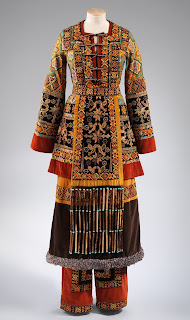 |
| House Model, Nayarit, Mexico 100 B.C.--A.D. 200 Ceramic and Pigment |
From the first millenium B.C. until the arrival of Europeans in the 16th century, artists from the ancient Americas created small-scale models to be placed in the tombs of important individuals.
These works in stone, ceramic, wood, and metal range from highly abstracted representations of temples and houses to elaborate architectural complex populated with figures.
The exhibit, Design for Eternity: Architectural Models from the Ancient Americas at the Metropolitan Museum of Art, the first of its kind in the United States, sheds light on the role of these objects and their relationship between the living, the dead and the divine.
Arranged chronologically, the exhibition features groups of works from ancient Mesoamerican and Andean cultures. Featured is an exceptional ceramic work, perhaps the finest example of a house model known from the Nayarit culture of West Mexico was made between 100 B.C. -- A.D. 200 and measuring 12 inches in height, and includes twenty-six figures engaged in a grand feast.
 |
| Ball-Court Model, Ceramic with Slip and other pigments |
Some thirty remarkable loans from museums in the United States and Peru join the works from the permanent collection of the Metropolitan Museum. While scant written documentation concerning how the artifacts used has survived. Maya hiero-glyphs call them "god houses: or sleeping places for the gods." Indeed, many of the artifacts combine a buildings shape and that of a vessel, and some of these double as musical arrangements. The centerpiece of the exhibition is a spectacular wooden model that depicts part of a pre-Inca palace at Chan Chan, the capital of
 |
| Pre-Inca Palace at Chan Chan, Chimu Empire |
The exhibition is accompanied by a catalog, Yale University Press, at the Museum's bookshops ($25.00, paperback). The exhibition is also featured on the Museum's website at www.metmuseum.org, as well as on Facebook, Instagram and Twitter via the following hashtage:#DesignforEternity.
Ta Ta darlings!!! Take time to visit this ancient world of wonder works that shed light on these ancient people and their relationships between the living, the dead, and eternal life. Fan mail always is welcome at pollytalknyc@gmail.com. Visit Polly's Blogs at www.pollytalk.com and in the left-hand column click on the link to the Blog that resonates with your interest.









